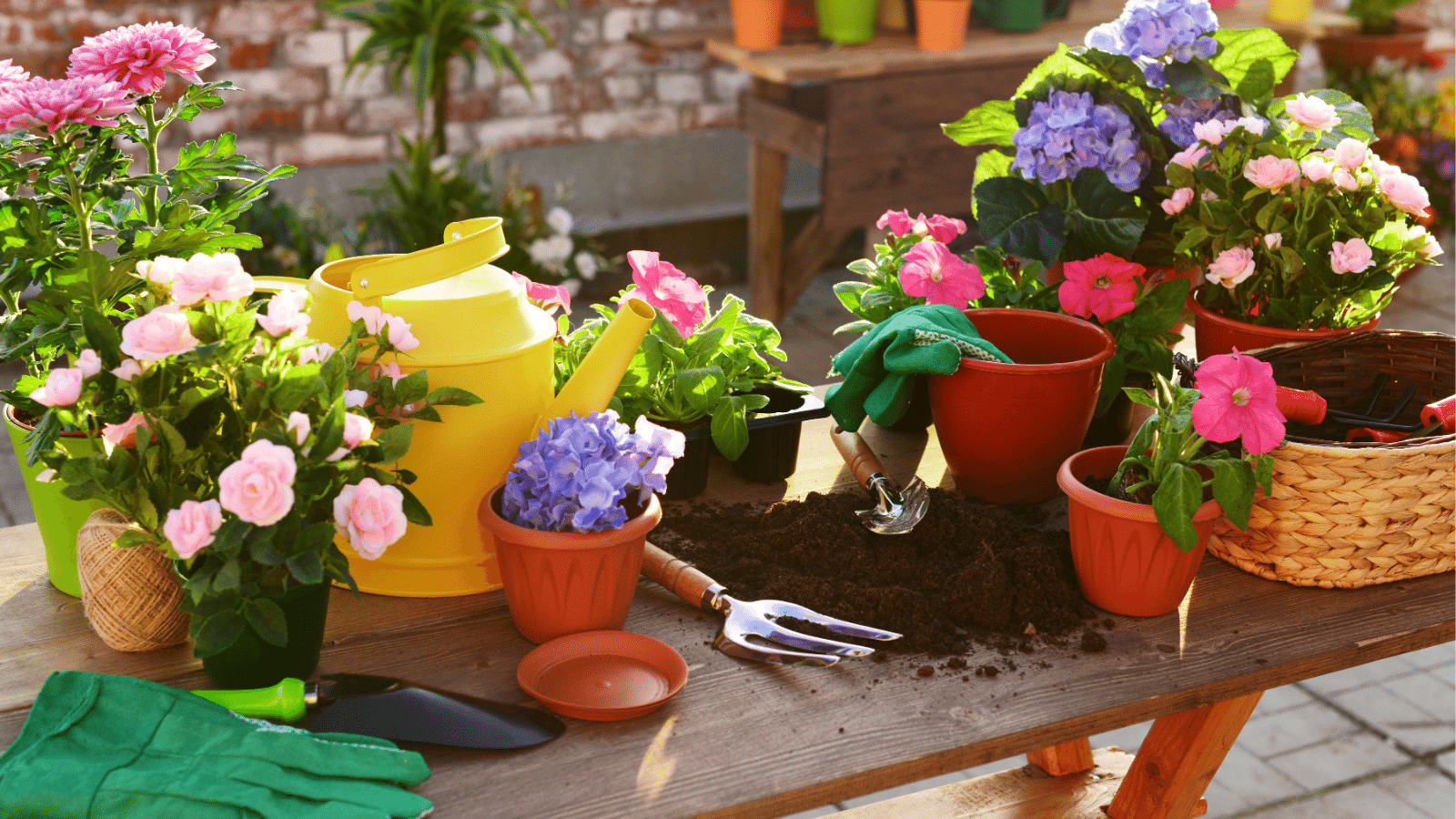In the hustle and bustle of urban living, finding room for a traditional garden can be a challenge. Container gardening offers hope to bring nature’s beauty into limited spaces. It’s a beacon.
Transform even the smallest balcony, patio, or windowsill into a lush oasis. It’s container gardening.
Brief Overview of Container Gardening
Container gardening is about growing plants in containers instead of in the ground. This method of gardening offers numerous benefits, including flexibility, mobility, and versatility.
Containers can go almost anywhere, from sunny balconies to shady corners. This helps gardeners utilize small spaces effectively. Container gardening gives you more control over the soil, so you can match it to what your plants need.
Importance of Container Gardening for Small-Space Dwellers
Living in small spaces, container gardening is more than just a hobby. It’s a way to experience nature in urban areas filled with concrete. Container gardening allows urban residents to connect with nature in limited spaces. It provides a much-needed opportunity due to lack of traditional garden plots.
Furthermore, growing plants in containers brings joy and fulfillment to gardeners. They feel proud and satisfied seeing their plants flourish, even in small spaces.
Container gardening gives small-space dwellers many options. They can grow fresh herbs and create a peaceful retreat in the city.
Selecting Containers
When starting your container garden, choose the right pots for your plants. To ensure your container garden thrives, remember a few important things.
Considerations for Choosing Containers
Material Options: Containers come in a variety of materials, each with its own set of pros and cons.
Terracotta pots look traditional and rustic. They help roots get more air but can dry out faster than other materials.
Plastic containers are lightweight, durable, and affordable. They are ideal for beginners.
Ceramic containers add a touch of elegance to any space but may be heavier and more prone to breakage.
Consider what you like and what your plants need when choosing pots. Different plants have different root systems and space needs. Choose containers that fit their requirements.
Larger and deeper pots work well for big plants with long roots like tomatoes and peppers. Smaller, shallow pots are great for herbs or lettuce.
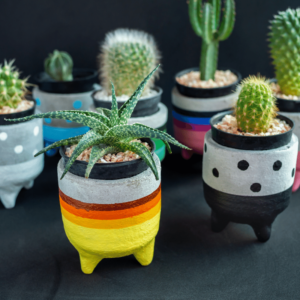
Importance of Drainage Holes and Proper Drainage
Regardless of what your containers are made of or how big they are, they must have drainage holes. Good drainage stops waterlogging, which avoids root rot and other issues.
Make sure your pots have holes at the bottom for water to escape easily. Raise them a bit so excess water can flow out freely.
Creative Container Ideas
Add personality and style to your garden by choosing unique containers. Reuse old buckets, cans, or wooden crates for a classic vibe. Try using teacups or rain boots for a fun twist.
Try hanging baskets, vertical planters, and window boxes for small garden spaces. Explore unique and functional container designs that reflect your personal style and creativity.
Choosing Suitable Plants
Selecting the right plants is crucial for a successful container garden. Consider these key factors to ensure your plants thrive in their container environment.
Factors to Consider When Selecting Plants for Containers
Light Requirements: Pay attention to the amount of sunlight your container garden receives. Some plants thrive in full sun, while others prefer partial shade or even full shade. Assess your area. Pick plants that like the light there to get enough sun for strong growth.
When container gardening, it’s important to select plants that have compact growth habits. This ensures they won’t grow too big for their containers too fast because space is limited.
When shopping for plants, choose smaller versions like dwarfs or bushes. Also, consider plants that hang or cascade for baskets or vertical planters.
When creating mixed containers, think about whether different plants will work well together. This helps ensure they can grow and thrive harmoniously.
Select plants that have the same needs for water and nutrients. This will prevent them from competing with each other and promote healthy growth.
Experiment with plant combos. Find the perfect mix for your container garden.
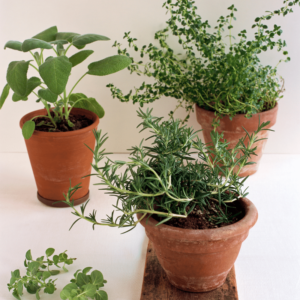
Recommended Plants for Container Gardening
Herbs: Herbs are an excellent choice for container gardening. They provide fresh flavors and aromas for culinary delights.
Basil, thyme, and rosemary are popular choices. These plants thrive in containers and require minimal maintenance.
Many veggies grow well in pots, allowing you to grow your own food even in tiny areas. Tomatoes, peppers, and lettuce are great options for growing vegetables in containers. They provide abundant harvests and can thrive in compact spaces.
Flowers: Add a pop of color and beauty to your container garden with flowering plants. Petunias, marigolds, and geraniums blossom abundantly and do well in pots.
Choose colors and textures for visually stunning container arrangements. Brighten up your space.
Consider factors, choose plants wisely for a thriving, beautiful oasis in tiny spaces.
Soil and Potting Mix
Ensuring your potted plants thrive means using the correct soil mix. It’s vital for their health and growth. Exploring why good soil is important and how to make the best mix for your plants is crucial.
Importance of Quality Potting Mix for Container Gardening
Good potting soil is important for your potted plants. It has the nutrients, structure, and drainage needed for healthy growth.
Garden soil can become compacted and waterlogged in containers. Potting mix is made to help roots grow well and hold water, while also letting excess water flow out. Invest in good soil for your plants to help them grow well all season.
Understanding Soil Composition and Nutrients
To make the right soil for your plant pots, you need to know what’s in the soil and about plant food. A good potting mix should be well-draining. It must retain moisture, provide nutrients.
You can add slow-release fertilizers or organic compost to your potting mix. This will help supply necessary nutrients to your plants over time. It promotes healthy plant growth and vitality.

Tips for Creating a Suitable Potting Mix for Containers
When making your potting mix, try to achieve a light and fluffy texture. This will help the roots grow well and ensure good drainage for the water.
Begin with a good potting mix. Mix in perlite or vermiculite for better drainage and airflow. To boost the soil quality, think about adding natural stuff like compost or aged manure. This helps the plants get more nutrients and makes the soil better.
In the end, adjust the pH of your potting mix as necessary to match the specific needs of your plants. This will ensure that they get the essential nutrients they need to grow and be healthy.
It is essential to understand the importance of quality potting mix. Follow these tips to make the right soil mix for your pots. This will help your container plants grow well all season.
Try different combinations and changes to create the ideal soil for your plants. Then, appreciate the beauty and abundance of your container garden.
Proper Watering Techniques
Properly watering your container garden keeps it healthy and vibrant. Key to proper watering is consistency and frequency. Recognize signs of overwatering and underwatering.
Importance of Watering Consistency and Frequency
Consistency and frequency are paramount when it comes to watering container plants. Establish a consistent watering routine to keep your plants healthy. This way, they get just the right amount of water to grow well and stay balanced.
Consistent watering maintains stable root environment. It promotes healthy growth and prevents stress problems.
Signs of Overwatering and Underwatering in Container Plants
Recognize signs of overwatering. Adjust your watering routine accordingly for plant health. Overwatering can cause plants to wilt, turn yellow, and suffer from root rot. Underwatering can make plants dry, brittle, and limit their growth.
Keep a close eye on your plants and watch how they react when you water them. This will help you find the right balance.
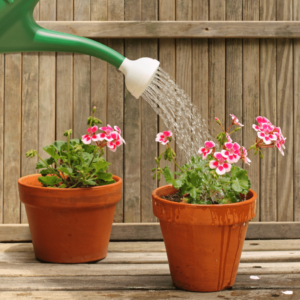
Best Practices for Watering Container Plants
Water at the plant’s base, not from above, to keep leaves dry and prevent fungus. This also encourages deep root growth and efficient water uptake.
Consider using self-watering containers or drip irrigation systems. They keep plants’ roots moist and save water. These systems are great for busy gardeners or when it’s hot and dry, and plants need more water.
Strategies for Conserving Water in Container Gardening
Save water by using strategies in container gardening for sustainability in practice. Mulching the soil surface helps retain moisture and suppresses weeds. Grouping containers together can create a microclimate that reduces evaporation.
You can also save water by collecting rainwater or reusing household graywater. This helps reduce your need for traditional watering methods.
Prioritize proper watering and use water-saving strategies. Ensure garden health and conserve water.
Fertilization and Nutrient Management
Healthy container plants need essential nutrients for optimal growth and productivity. Explore the importance of understanding their nutritional needs.
Regular fertilization is significant. Different types of fertilizers and application methods are available.
Understanding the Nutritional Needs of Container Plants
Container plants rely on you to provide them with the nutrients they need to thrive. Container plants, unlike plants in the ground, don’t have as much access to the nutrients in the soil.
As a result, they can use up the available nutrients in their growing medium more quickly. Knowing plant nutritional needs ensures proper nutrient balance in correct quantities. It’s crucial.
Importance of Regular Fertilization in Container Gardening
Regular fertilization is crucial for nutrients in container gardens. It sustains healthy plant growth.
As plants grow, they need important nutrients such as nitrogen, phosphorus, and potassium. These nutrients help plants stay healthy and produce colorful leaves, flowers, and fruits.
Failing to fertilize regularly can cause nutrient deficiencies. It may lead to stunted growth and diminished yields.
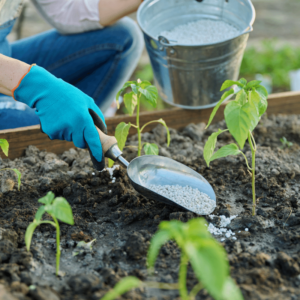
Different Types of Fertilizers and Their Application Methods
Different types of fertilizers for container gardening include granular, liquid, and slow-release options. Choose based on your needs.
Granular fertilizers are put on top of the soil and release nutrients slowly. Liquid fertilizers are dissolved in water and applied to the soil or foliage. Slow-release fertilizers provide nutrients slowly over time for steady plant nourishment. This ensures a consistent supply of nutrients to plants.
Choose the right fertilizer and how to apply it based on your plants and how you prefer to garden.
Organic Options for Fertilizing Container Plants
For organic gardening practices, several organic fertilizers are suitable for container plants. Organic options like compost provide nutrients. They promote soil health and microbial activity.
Use organic fertilizers for healthier plants and adopt a more sustainable gardening approach.
Understand your plants’ needs. Regularly fertilize with suitable options. Use organic choices. Keep your container garden thriving. Enjoy abundant harvests and vibrant blooms.
Maintenance and Care
Taking care of your potted plants is crucial for keeping them healthy and vibrant. Let’s look at how to care for potted plants and make them last longer.
Pruning and Deadheading Container Plants for Optimal Growth
Regular pruning and deadheading promote optimal growth. They enhance flowering in container plants.
Pruning shapes plants, controls size, promotes new growth, and removes dead leaves. By removing old flowers, deadheading helps plants bloom more and look better.
Pest and Disease Management in Container Gardening
Pest and disease management are ongoing tasks in container gardening. Inspect plants for aphids, spider mites. Look for powdery mildew too.
Address pest and disease problems quickly. Use insecticidal soap for pests and fungicides for fungal infections.
Practice good sanitation, proper watering, and adequate spacing between plants. This can prevent pest and disease problems.
Seasonal Maintenance Tasks for Container Plants
Keeping your potted plants healthy all year requires regular maintenance tasks.
In spring, update soil, trim plants from winter, and add fertilizer for new growth.
In summer, check water for plants, remove old flowers, and give shade from the sun.
In the fall, clean up debris. Bring sensitive plants indoors before frost. Prepare for winter dormancy.
During winter, make sure to keep your containers safe from freezing temperatures. Also, water them less often and trim dormant plants as necessary.
Tips for Extending the Lifespan of Containers and Plants
To extend the lifespan of your containers and plants, practice proper container maintenance. Regularly clean your containers to get rid of dirt and debris. These can attract pests and diseases.
Inspect the containers for any wear or damage. Fix or replace them as necessary to avoid root damage or drainage issues.
To improve the health and longevity of your containers, try using liners or pot feet. These can enhance drainage and airflow, promoting healthy plant growth.
Include maintenance in your gardening routine for a beautiful garden all year. Your container plants thrive with proper care, rewarding you with joy and satisfaction. Enjoy bountiful blooms and lush foliage.
Design and Aesthetics
In container gardening, the way things look is really important. It helps turn regular spaces into amazing garden hideaways.
Let’s explore why design and aesthetics are vital for visually appealing gardens. Include decorative elements for stunning container arrangements in your garden designs.
Importance of Aesthetics in Container Gardening
In container gardening, how your garden looks is just as important as how it grows. Your garden needs to look nice to be a welcoming and balanced space.
Container arrangements enhance any space, from a small balcony to a windowsill garden. Container gardening can make the space beautiful because of the arrangement of the plants.
Tips for Creating Visually Appealing Container Arrangements
When designing container arrangements, consider the principles of balance, proportion, and color harmony. Mix plants of different heights, textures, and colors. Create dynamic compositions with eye-catching appeal.
Begin with a main plant, like a tall grass or blooming shrub. Surround it with other plants of various heights and shapes.
When arranging your plants, make sure to consider the structure too. Aim to distribute the plants evenly for an appealing look from all angles.
Incorporating Decorative Elements and Accessories into Container Designs
Decorative items enhance your container garden, in addition to plants. Try adding rocks, pebbles, or driftwood for texture and interest in your arrangements.
Experiment with decorative containers or pots in different materials, colors, and shapes. They can complement your plant selection and add personality to your garden.
Remember to consider practical items such as trellises, stakes, and plant supports. These accessories offer structural support and add vertical interest to your container designs.
Prioritize design in container gardening for captivating and inspiring garden spaces. Delight senses. Transform small spaces into lush havens with planning, creativity, and imagination. Thus beautify with ease.
Maximizing Space with Vertical Gardening
Vertical gardening is a game-changer for anyone who wants to maximize limited space. Exploring vertical gardening creates new options for small spaces. We’ll also share creative ideas and recommended plants for your vertical container gardens.
Introduction to Vertical Gardening Techniques for Small Spaces
Vertical gardening means growing plants up, not out. It uses walls, fences, or trellises to save space. Ideal for small gardens, balconies, or indoor spaces. Innovative approach for limited floor space.
Vertical gardens make the most of space and add beauty and greenery to walls. They turn plain walls into vibrant displays of plants and flowers.
Creative Ideas for Vertical Container Gardens
Get creative with your vertical container gardens by exploring different planting techniques and container options. Try hanging baskets, wall planters, or shelves for more vertical greenery.
Mix plants with different heights, textures, and colors. Create stunning displays. Try using trellises, ladders, or old pallets to help climbing plants grow up. It also adds vertical interest and architectural flair to your garden space.
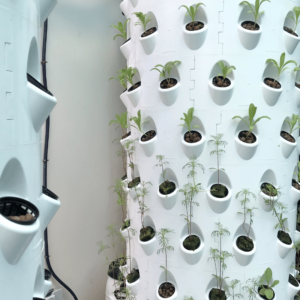
Recommended Plants for Vertical Gardening
Choose plants that are good for vertical gardening. Look for ones that grow upward and have a compact or trailing growth habit.
Climbing plants such as ivy, jasmine, or climbing roses grow well in vertical areas. They can add height and structure to your garden.
Trailing plants like petunias and succulents are ideal for hanging baskets. They create beautiful cascades of foliage and blooms.
Embrace vertical gardening for maximizing space. Explore creative ideas for vertical gardens. Unleash your creativity.
Vertical gardening offers countless possibilities with the right plants and design elements. It can elevate your living spaces beautifully.
Conclusion
Let’s recap key tips. Start your container gardening journey. Share experiences and tips.
Recap of Key Tips for Successful Container Gardening
Container gardening provides many opportunities. It is great for limited spaces. For successful container gardening, attention to detail, creativity, and care are key. Properly select containers, plants, water, fertilize, maintain.
Remember to pick containers with good drainage. Choose plants that fit your area and light. Take care of your container garden regularly to keep it healthy.
Encouragement for Readers to Embark on Their Container Gardening Journey
For those starting container gardening, I provide encouragement and inspiration to begin. Container gardening allows you to connect with nature and unleash your creativity. Transform small spaces into lush, vibrant oases of greenery.
If you love to garden, whether you’re experienced or just starting out, now is the perfect time to begin. Discover the joys of container gardening with dedication, patience, and trial and error. You’ll experience wonders firsthand.
Invitation to Share Experiences and Tips
Share your container gardening experiences, tips, and insights in the comments below. Feel free to contribute, dear readers.
If you have been doing this for a while or if you are new, we appreciate and value your contributions.
Join us as a community to celebrate our shared love for gardening. We can exchange ideas and support each other on our container gardening journeys. Because these gardens will bring joy and beauty to our lives and spaces.
is a digital marketer and avid gardener passionate about sharing gardening tips and inspiration. Join him on a green journey to cultivate beauty and abundance in your garden. Follow Mazharul on social media for more gardening insights and subscribe to the newsletter for exclusive content!

